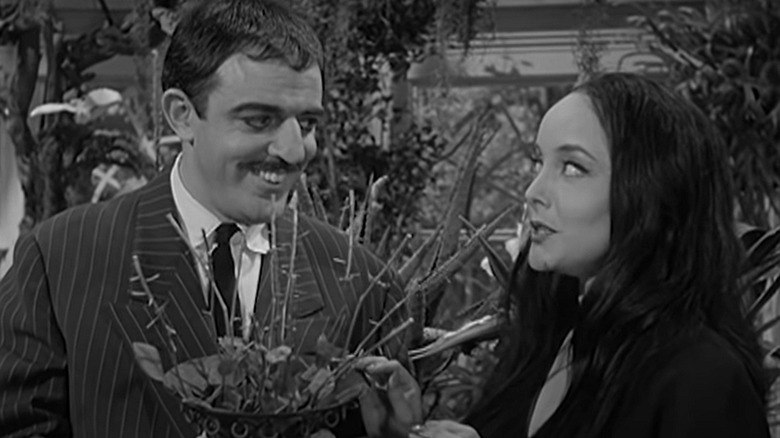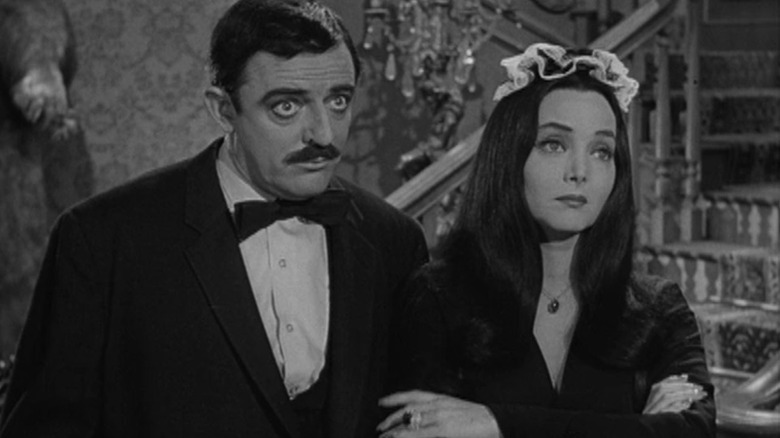The Addams Family Show Got The Comic Banned From The Magazine That Made It Famous
Charles "Chas" Addams began working as a cartoonist for the New Yorker in 1932, regularly turning out single-panel cartoon strips, typically with a macabre edge. In 1938, he drew a strip with a striking family of ghouls living in a haunted mansion, clearly rejecting the cleanliness, light, and verve of average American homes. The unnamed haunted house family soon began making regular appearances in the New Yorker, eventually rounding out to seven members. The creepy clan, nicknamed the Addams Family, appeared in 58 of Addams' strips in the 1950s. They were very popular and, by the early 1960s, were even inspiring merchandise. The matriarch of the family, Morticia, and her daughter Wednesday were first given names for a little-known doll line released in 1962.
Addams' family was adapted into a TV sitcom in 1964 (called, natch, "The Addams Family"), further cementing their place in the pop culture firmament. For the series, every member of the family was finally given a name. Morticia was played by Carolyn Jones and the young Wednesday by Lisa Loring. The family was rounded out by patriarch Gomez (John Astin), son Pugsley (Ken Weatherwax), Gomez's brother Fester (Jackie Coogan), Morticia's mother Grandamama (Blossom Rock), and the family butler Lurch (Ted Cassidy). The family also owned a severed hand in a box named Thing (credited as "Itself," but usually performed by either Cassidy or assistant director Jack Voglin) and their Cousin Itt (Felix Silla, Roger Arroyo) lived in their chimney. The show was instantly popular.
However, according to various sources around the internet (including an artist profile at the Swann Gallery and a 2019 article in Smithsonian Magazine), the sitcom caused a bit of a stir at the New Yorker offices. It seems that editor William Shawn hated the "Addams Family" sitcom so much (mainly for its "low" humor) that he banned Chas Addams from drawing any more Family cartoons. The ban remained in place from 1964 until Shawn's departure in 1987.
The editor of The New Yorker hated the Addams Family sitcom
The New Yorker has long been associated with a certain kind of cosmopolitan class, publishing only the highest-quality journalism and best possible writing for curious and intellectual readers. Chas Addams' strips were a grim, winking aside in such a milieu, a secret handshake for adults. The sitcom, compared to the strips, was less wry and certainly less macabre. It was also zanier and more reliant on jokes and slapstick. In the strips, the Gomez character was a squat ogre. On the TV series, however, Astin turned him into a charming, wild-eyed lothario ... but only for Morticia. Indeed, there's a palpable element of sexual chemistry between Gomez and Morticia that's never implied in the comics.
Shawn didn't want the New Yorker to be associated with a mainstream TV sitcom. The New Yorker was a "high art" publication, whereas Shawn clearly saw an ABC sitcom as "low art." The series might've been high-quality and popular, but to Shawn, it was in a different class. As mentioned, the ban remained in place for as long as Shawn served as the New Yorker's editor. Chas Addams finally made Addams Family strips again in 1988 after Shawn retired. Sadly, Addams died later that year.
During the ban, however, Addams was clever, working members of the Addams Family into the backgrounds of other New Yorker comics he produced. The Swann Gallery website boasts that a 1979 Addams strip (which sold at auction in 2017 for $16,250) features Uncle Fester and Grandmama as passengers on a subway train. Sharp-eyed fans might also spot Gomez and Morticia peeking through crowds here and there.
The sitcom was canceled in 1966, but by then, "The Addams Family" was a media franchise unto itself. There have since been two animated shows, a reboot of the sitcom, two live-action films, two animated films, and whatever Netflix's "Wednesday" counts as.

